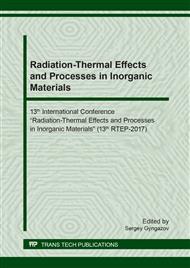p.143
p.149
p.155
p.159
p.165
p.170
p.176
p.185
p.190
Surface Geometry Model of the Capillary when Filling it with Liquid
Abstract:
Nondestructive penetrant testing is effective, and in some cases, it is the only possible method of accidents prevention at high-risk sites. But in nowadays liquid-filled discontinuity model has not been adequately studied. Hydrodynamics in the open-end capillaries characterize the flow of liquids using the methods of leak detection. To detect surface discontinuities that are capillary, capillary flaw detection methods are used. Until now, the theoretical relation l = l (t) has not been find out. This relation makes it possible to calculate the absorption kinetics in any capillary at all its stages, which would coincide with experimental data with high accuracy. The studies show that the time of filling the capillaries by liquid is usually higher than the theoretically predicted one. Therefore, revealing the regularities of filling capillaries with liquids to the maximum depth and the duration of filling the capillary with liquid by a given depth is an actual task. The authors suggest a model for determining the velocity of fluid in dead-end and open-end and through capillaries, which take into account the fractal topology of the surface.
Info:
Periodical:
Pages:
165-169
Citation:
Online since:
September 2018
Price:
Сopyright:
© 2018 Trans Tech Publications Ltd. All Rights Reserved
Share:
Citation:


